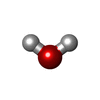+Search query
-Structure paper
| Title | Fast event-based electron counting for small-molecule structure determination by MicroED. |
|---|---|
| Journal, issue, pages | Acta Crystallogr C Struct Chem, Vol. 81, Issue Pt 3, Page 116-130, Year 2025 |
| Publish date | Mar 1, 2025 |
 Authors Authors | Niko Vlahakis / Songrong Qu / Logan S Richards / Lygia Silva de Moraes / Duilio Cascio / Hosea M Nelson / Jose A Rodriguez /  |
| PubMed Abstract | Electron counting helped realize the resolution revolution in single-particle cryoEM and is now accelerating the determination of MicroED structures. Its advantages are best demonstrated by new ...Electron counting helped realize the resolution revolution in single-particle cryoEM and is now accelerating the determination of MicroED structures. Its advantages are best demonstrated by new direct electron detectors capable of fast (kilohertz) event-based electron counting (EBEC). This strategy minimizes the inaccuracies introduced by coincidence loss (CL) and promises rapid determination of accurate structures. We used the Direct Electron Apollo camera to leverage EBEC technology for MicroED data collection. Given its ability to count single electrons, the Apollo collects high-quality MicroED data from organic small-molecule crystals illuminated with incident electron beam flux densities as low as 0.01-0.045 e/Å/s. Under even the lowest flux density (0.01 e/Å/s) condition, fast EBEC data produced ab initio structures of a salen ligand (268 Da) and biotin (244 Da). Each structure was determined from a 100° wedge of data collected from a single crystal in as few as 50 s, with a delivered fluence of only ∼0.5 e/Å. Fast EBEC data collected with a fluence of 2.25 or 3.33 e/Å also facilitated a 1.5 Å structure of thiostrepton (1665 Da). While refinement of these structures appeared unaffected by CL, a CL adjustment applied to EBEC data further improved the distribution of intensities measured from the salen ligand and biotin crystals. However, CL adjustment only marginally improved the refinement of their corresponding structures, signaling the already high counting accuracy of detectors with counting rates in the kilohertz range. Overall, by delivering low-dose structure-worthy data, fast EBEC collection strategies open new possibilities for high-throughput MicroED. |
 External links External links |  Acta Crystallogr C Struct Chem / Acta Crystallogr C Struct Chem /  PubMed:39982366 / PubMed:39982366 /  PubMed Central PubMed Central |
| Methods | EM (electron crystallography) |
| Resolution | 1.5 Å |
| Structure data |  PDB-9cq0: |
| Chemicals |  ChemComp-HOH: |
| Source |
|
 Keywords Keywords | ANTIBIOTIC / Cyclic / macrocycle |
 Movie
Movie Controller
Controller Structure viewers
Structure viewers About Yorodumi Papers
About Yorodumi Papers



 streptomyces azureus (bacteria)
streptomyces azureus (bacteria)